Kitchen: Artichokes, California's Official State Vegetable
Most commercial farms have switched to thornless varieties, but two farms still grow the delicious Green Globe. Here is a bit of history, with 4 great recipes.
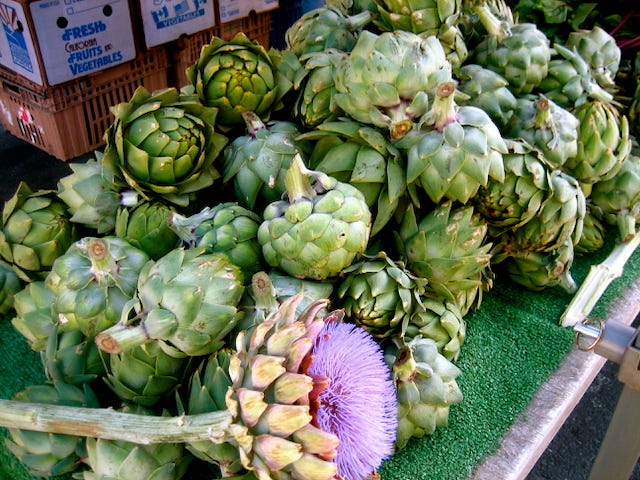
When Gavin Newsom was our lieutenant governor, he declared the artichoke our official state vegetable. The declaration, made on April 11, 2013, was the result of a poll taken by a Bay Area radio station, and, perhaps surprisingly, this time the public got it right. The artichoke is one of California’s most delicious claims to fame.
In my home state, it is easy to take the artichoke for granted, forgetting that in other parts of the country people may never have seen one except in a can or a jar. I have always eaten fresh artichokes, with garlic butter as a little girl, later with mayonnaise or vinaigrette, and, now, every which way: in salads and pasta sauces, in soups and stews, grilled, dipped into a hot bath of olive oil, garlic, and anchovies, and frequently simply as they are, boiled until tender, unadorned and unseasoned except for a sprinkle of coarse-grain salt on the tender heart.
Although artichokes are available fresh all year, the season peaks between March and May, when more than half of the annual crop is harvested. A smaller crop peaks in October.
The artichoke’s presence is nowhere more visible than in Castroville, the small Monterey County town that declared itself the Artichoke Center of the World and celebrates its official vegetable with a huge statue, roadside stands and cafés offering deep-fried artichokes and other yummy artichoke dishes, and a festival, founded in 1959.

Artichokes are native to Sicily; Italian immigrants first planted them here in the 19th century. By 1900, 500 acres filled the strip of fertile coastal land south of San Francisco. Today nine California counties –Monterey, San Mateo, Santa Cruz, San Benito, Sutter, Ventura, Santa Barbara, Orange, and Imperial – grow virtually all of the commercial artichokes harvested in the United States, with 8400 acres yielding nearly 4 million cartons of the delicious thistle each year. In Monterey, the plants are ubiquitous; I remember driving through the peninsula where for miles there seemed to be nothing but vast fields of silvery sage-green plants cloaked in a blanket of Pacific fog.
That fog is essential to the plant: a few Sonoma County farmers grow artichokes but most of the region is too hot for a commercial crop to thrive. “It just wasn’t profitable,” Joe Imwalle of Santa Rosa’s Imwalle Gardens explains when I ask him why he no longer grows artichokes. “You can buy them much cheaper from the Watsonville area; it’s a little too warm here.”
Oregon and Washington grow artichokes, too, but not enough to matter in commercial production.
Artichokes taste best when there has been a freeze and these artichokes, which some people call ugly, are marketed as “frost-kissed,” so that consumers understand that they are not flawed.

A word about wine: It can be tricky to pair a wine successfully with artichokes, as the thistle will make most wines seem slightly sweet, which is what happens, as well, if you take a sip of milk after taking a bit of artichoke. You can read through my list of successful pairings here.
Basic Boiled Artichokes
When I teach cooking, either in person, in an article, or through one of my books, I do not always use recipes, especially for basic cooking. To become a good home cook, it is best to learn basic preparations of certain foods without referring to a recipe. Cooking artichokes is one of those things home cooks should be able simply to do.
The best way to cook artichokes is to boil them in salted water, but you must take care not to overcook them.
Here is how I do it: I first trim the stem end of the artichokes so that they sit flat. Next, I turn them, one by one, on to their side. Holding an artichoke in place with my left hand, I use a very sharp knife to cut about half an inch off the tip of the artichoke and then I drizzle a bit of olive oil into the center of each.
After nestling artichokes into a pot that will hold them snuggly, I add hot water until it comes at least three-quarts of the way up the artichokes. Next comes a couple of tablespoons of salt and, after adding it, I jostle the pan a bit to distribute it.
With the pot set over high heat, I bring the water to a boil, reduce the heat so that the water simmers gently, cover the pan, and set the timer for 12 minutes for thornless varieties, 18 minutes for small-medium Green Globes and 25 minutes for large Green Globes.
When the timer goes off, uncover the pot and use tongs to tug at a middle leaf (half way between the outer edge and the center). If you can pull it off with just a tad of resistance, remove the artichokes from the water and set them, upside down, in a colander to drain. If the leaf resists your efforts, cover, and test again in about 7 minutes. After about 25 minutes, remove one artichoke from the pot and poke a toothpick or bamboo skewer into the stem end. If it glides in with just a bit of resistance, it is ready. If it won’t go in at all, cook for another 7 minutes or so and test again.
Continue cooking and testing until the artichokes are just tender but not at all soft or mushy. Now that the Green Globe varieties no long dominate the commercial market, it is important to test for doneness frequently, as many thornless varieties cook quickly. That said, some take longer to become tender but can still quickly become mushy.
One more thing to consider: If you don’t have a pot to hold the artichokes snugly so they don’t float, you’ll have to put a smaller lid on top of them to keep them submerged.

Grilled Artichokes with Pistachio Mayonnaise • Makes 4 Servings
For the best grilled artichokes, boil them until they are almost tender, but not mushy. If you are not certain they are done, use tongs to remove one, and hold it upside down. Insert a tooth pick or bamboo skewer through the center of the stem end; if it slides in with a bit of resistance, the artichokes are done. Do not overcook them.
This dish calls for a raw egg yolk. If you have qualms about using raw eggs in this time of avian flu, use commercial mayonnaise, preferably Hellman’s/Best Foods. Put a cup of the mayonnaise into a small bowl, add about 2 teaspoons of fresh lemon juice, a tablespoon of olive oil, and a few pinches of salt. Whisk well and fold in the pistachios.
2 large artichokes, preferably Green Globe variety Olive oil Kosher salt 1 large egg yolk Black pepper in a mill 1 teaspoon fresh lemon juice, plus more to taste 1 cup extra-virgin olive oil preferably a late harvest variety ! tablespoon boiling water, as needed ½ cup shelled pistachios, lightly toasted
Using a sharp knife, cut the stem of the artichoke so that it sits flat. Set one on its side and cut about ½ inch off the top. Cut the second artichoke in the same way. Drizzle about a teaspoon of olive oil into the center of the artichokes.
Pour water into a medium saucepan, filling it about ⅔ full. Add a very generous tablespoon of salt and tuck the artichokes into the pot. Set a small lid on top of the artichokes to keep them submerged and set over high heat. When the water boils, reduce the heat so that they simmer gently and cover the pan.
After 20 minutes, remove both lids and use tongs to wiggle a leaf, pulling upward carefully. If it doesn’t give at all, cook for another 10 minutes and test again; repeat until it takes just a bit of effort to pull off the leaf. Transfer to a colander to drain and cool.
While the artichokes cook, make the mayonnaise. To do so, put the egg yolk into a small glass, stainless steel, or ceramic mixing bowl. Whisk in a generous pinch of salt, a few turns of black pepper, and the lemon juice. Use a whisk to slowly add the oil, just a few drops at a time at first and then increasing a bit as they emulsion forms. Continue until the mixture thickens and increases in volume. When all of the oil has been incorporated, taste the mayonnaise. If it tastes flat, sprinkle several pinches of salt on top and pour the boiling water over it so that it dissolves; whisk it in. If you want more tartness, use lemon juice instead of water.
Working quickly, chop the pistachios into small pieces or grind them in a small food processor or spice grinder. Fold into the mayonnaise, cover, and refrigerate.
When the artichokes have cooled, set one at a time on a surface. Set it on its side and use a very sharp knife to cut it in half, lengthwise; repeat with the second artichoke. Cut the chokes from the hearts and discard them. Brush all the cut parts with olive oil.
Heat a stovetop grill or grill pan until it is quite hot. Set the artichokes, cut side down, and grill for about 3 minutes, rotate 45 degrees, and cook another 3 to 5 minutes.
Transfer the artichokes to individual plates, spoon mayonnaise into the cavity, and enjoy right away.
Variation: Grill 8 trimmed green onions until limp and add to the plates. Quickly make a lemon vinaigrette, and spoon it over the artichokes before adding the mayonnaise.
Spring Spaghettini with Artichokes, Olives, & Green Peppercorns • Makes 4 Servings
Brined green peppercorns are a favorite ingredient but they can be hard to find. Most supermarkets have them, typically on a high shelf near pickled capers. Staff often can’t find them, so you will likely have to look yourself. It is intuitive to look on the spice shelves but I have never found them there. The most common brand is Reese’s.
Kosher salt 12 ounces spaghettini or linguini 3 large artichokes, preferably Green Globe, cooked, drained, and cooled 4 garlic cloves, peeled and crushed 2 to 3 anchovy fillets (optional) 2 teaspoons green peppercorns in brine, drained Juice of 2 lemons ⅓ cup extra virgin olive oil, plus more as needed ¾ cup pitted green olives, such as picholine or lucques, minced 1 teaspoon minced fresh tarragon (optional) ¼ cup minced fresh Italian parsley Black pepper in a mill ¾ cup toasted bread crumbs 3 chive flowers, cut to release into individual florets, optional
Fill a large pot two-thirds full with water, add 2 tablespoons kosher salt, and bring to a boil over high heat. Add the pasta, stir several times, and cook until it is just done (check package directions for exact times, and begin tasting at least 90 seconds before you expect it to be cooked al dente). Drain the pasta but do not rinse it. Tip it into a wide shallow bowl.
Meanwhile, pull the leaves off the artichokes and discard the tough, dark outer leaves. Stack 3 to 4 of the tender leaves and make two crosswise slices to julienne the edible portion. Continue until all leaves have been cut. Put the julienned artichokes into a small bowl.
Use a sharp paring knife or a grapefruit spoon to remove the choke from each artichoke heart. Trim the bottoms and cut each heart into 3 crosswise slices; dice the sliced heart and add to the julienned leaves.
Put the crushed garlic and anchovies in a mortar or suribachi and use a pestle to grind them to a paste. Add the green peppercorns, crush gently, and stir in the lemon juice.
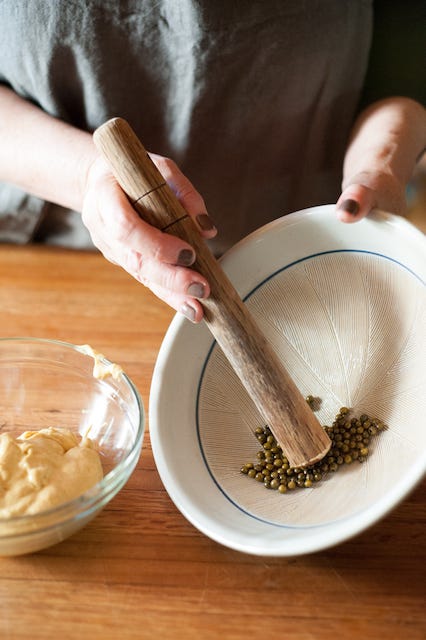
Pour the olive oil into a large sauté pan, stir in the garlic mixture, add the artichokes and the olives, and set over very low heat. Stir or toss until just heat through, add the tarragon, if using, and remove from the heat.
Add the artichoke mixture to the pasta and toss gently and thoroughly. Sprinkle with the Italian parsley, add several turns of black pepper, and the bread crumbs. Toss again, add the chive flowers, if using, and enjoy right away.
Artichoke Risotto • Serves 4
Here is a favorite risotto, earthy and rich and a bit tangy, too. For a dramatic presentation, cook 8 artichokes instead of four. Set the four largest ones aside. When they are cool, use your fingers to gently spread the leaves, pressing the outer 3 or 4 layers outward and downward, so they form a star of sorts. Gently pull out the inner leaves and enjoy them on their own. Use a grapefruit spoon or a sharp knife to scoop out the choke and any of its fiber from the heart. Squeeze a little lemon juice into the heart and season it with salt and pepper. Set on individual dinner plates and, when the risotto is ready, place it inside the scooped out artichokes. To truly gild the lily, top each portion with a dollop of artichoke tapenade.
4 large artichokes, preferably Green Glob, cooked until just tender, cooled, cleaned and separated into leaves and hearts (see recipe for Basic Artichokes, below) 2 tablespoons olive oil 2 tablespoons butter 2 shallots, cut into small dice 3 garlic cloves, minced Kosher salt 1 ¼ cup Carnaroli or Vialone Nano rice 4 to 5 cups homemade chicken stock 1 cup hot water, plus more as needed 2 teaspoons grated lemon zest 2 tablespoons chopped Italian parsley 3 ounces Italian fontina, in small pieces Black pepper in a mill
Cut the artichoke hearts into thin crosswise slices and set them aside.
Cut the meat from the tip of the leaves, using a sharp knife to make two slices, close together, at the tip of each leaf. Fluff the slices with your fingers and transfer to a bowl; set aside.
Pour the stock into a saucepan, add the hot water, and keep warm over a low flame. Add more hot water as needed.
Put olive oil and butter into a medium saucepan, such as an All Clad saucier, set over medium heat. Add the shallots and sauté until soft and fragrant, about 8 to 9 minutes; do not let them brown. Add the garlic, sauté 1 minute more and season lightly with salt.
Add the rice and cook gently, stirring all the while, until each grain turns milky white, about 2 minutes.
Begin adding stock, ½ cup at a time, stirring after each addition until nearly all the liquid has been absorbed. Adjust the heat as necessary as you cook.
After the fourth addition of stock, fold in the sliced artichoke hearts. Continue cooking and adding stock until the rice is tender but not mushy, about 18 to 20 minutes total cooking time.
Stir in the lemon zest, half the julienned artichoke leaves, parsley, and cheese, taste, correct for salt and add several turns of black pepper.
After the final addition of stock, remove from the heat and ladle into soup plates. Garnish with the remaining julienned artichoke and enjoy right away.
Variation: Top each serving with a 2-minute poached egg and drizzle with a bit of ultra-premium extra virgin olive just before sercving.
Artichoke, Green Olive, & Walnut Tapenade •Makes About 2 ½ Cups
Commercial artichoke tapenade is typically disappointing. Most taste like canned or frozen artichoke hearts but a benefit of living in coastal California is the availability of fresh artichokes during their two seasons, early to late spring and a shorter harvest in the fall. It has become difficult to find Green Globe artichokes, once the primary commercial variety, as they have been pushed aside by thornless varieties. Like watermelons grown to be seedless, these thornless artichokes are typically disappointing, especially if you have long loved Green Gloves, as I have. They are less meaty and usually require shorter cooking times than Green Globes.
1 baguette 3 large artichokes, preferably Green Globe variety (with thorns) 1 tablespoon olive oil 3 garlic cloves 2 or 3 anchovy fillets, drained 2 teaspoons green peppercorns in brine, drained 1 teaspoon minced lemon zest 1 tablespoon fresh lemon juice ½ cup extra-virgin olive oil 1 cup (6 ounces) cracked green olives, pitted and minced ¼ cup (2 ounces) walnut pieces, toasted and minced 1 tablespoon Italian parsley, minced Black pepper in a mill
Failed to render LaTeX expression — no expression found
Preheat the oven to 325 degrees.
While the oven comes to temperature, cut the baguette into thin diagonal slices. Arrange the slices on a baking sheet, set in the oven, and toast, turning once, until they are golden brown, about 10 minutes. Remove from the heat and let cool.
Fill a large pot two thirds full with water, add the salt, and bring to a boil over high heat. Using kitchen shears or a very sharp knife, snip off the tips artichoke leaves, cut about ½ inch from the top. Drizzle a little of the olive oil in the center of each artichoke and carefully set in the pot. When all three artichokes have been added and the water has returned to a boil, reduce the heat, and simmer gently until the artichokes are tender, from 20 to 40 minutes, depending on their size, age, and variety.
Meanwhile, use a suribachi or mortar and pestle to grind the garlic and anchovies together until they form a smooth paste. Use a rubber spatula to fold in the green peppercorn, lemon zest and juice, and extra-virgin olive oil, scraping the sides of the bowl as you mix. Set aside.
Transfer the artichokes to a colander or strainer, rinse under cool water, drain thoroughly, and let cool. When cool enough to handle, remove all of the leaves, reserving them for another use. Use a teaspoon or a small, sharp paring knife to cut away the choke in the center of each artichoke heart. Discard the chokes and cut the hearts into 1/4-inch dice.
In a medium bowl, combine the diced artichoke hearts, olives, walnuts, and olive oil mixture. Add the parsley (or tarragon) and several turns of black pepper. Taste and season with salt. Let rest 30 minutes before serving.
To serve, spread a little ricotta on each crouton, top with tapenade, and serve immediately.
Serving Suggestions:
•Spread creme fraiche or ricotta on toasted baguette slices or toasted walnut bread and top with a spoonful of tapenade.
•Toss with hot pasta – linguine or spaghettini (thin spaghetti) – and enjoy right away, with or without a generous dollop of creme fraiche on each serving.
•Cut mozzarella fresca into very thin slices, set on lightly toasted sourdough bread, and top with tapenade.






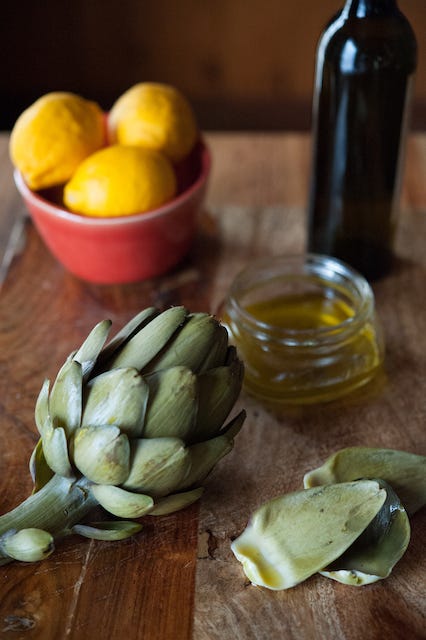
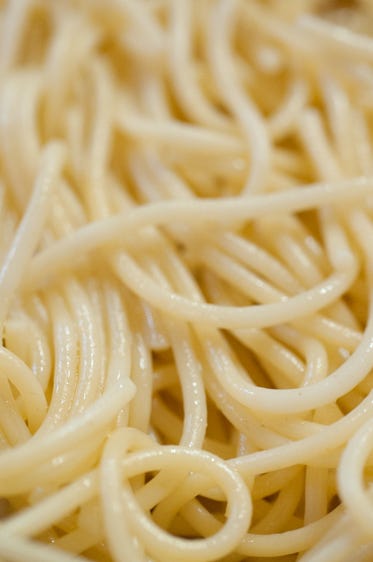
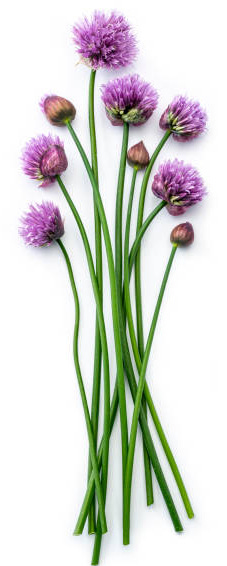
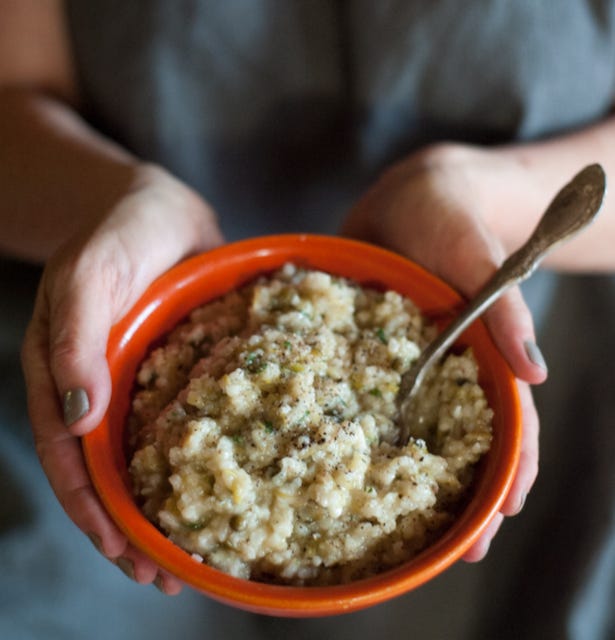

I love artichokes! Great recipes as always. Cant wait to try them all!
Yum! Can’t wait to try these. My favorite vegetable. Finding good ones in FL is nearly impossible.